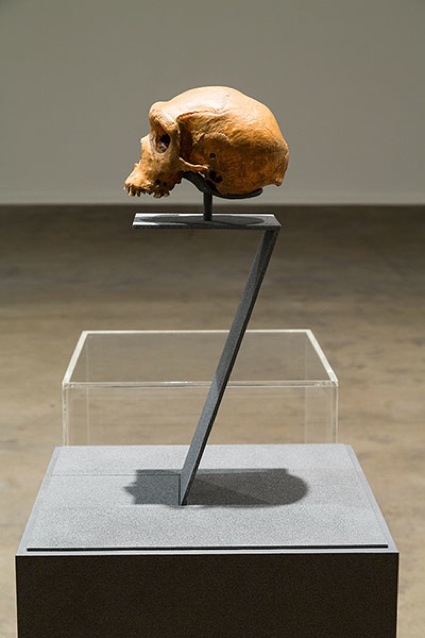 Pratchaya Phinthong, Broken Hill, 2013. Commissioned by Chisenhale Gallery. Photo: Mark Blower
Pratchaya Phinthong, Broken Hill, 2013. Commissioned by Chisenhale Gallery. Photo: Mark Blower
The first early human human fossil found in Africa that provides a key evidence to support Darwin’s theory of human evolution (and in particular the origin of anatomically modern humans to sub-Saharan Africa) was discovered by a Swiss miner in 1921 in a lead and zinc mine in Broken Hill, Northern Rhodesia (now Kabwe, Zambia.) An upper jaw from another individual, a sacrum, a tibia, and two femur fragments were also uncovered. Anything else was lost during the mining exploitation of the area. The skull, dated to be between 125,000 and 300,000 years old, was taken to London by the British colonial authorities -in violation of protocols put in place by the British South Africa Company- and it is still there, as part of the collection of Natural History Museum. Meanwhile, the Lusaka National Museum, in Zambia, is only exhibiting a replica of the cranium.
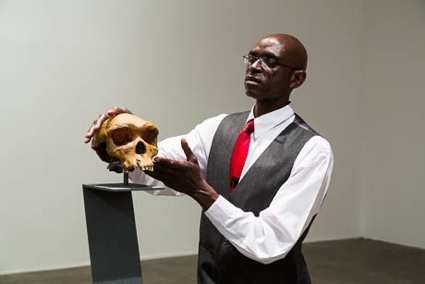 Pratchaya Phinthong, Broken Hill, 2013. Commissioned by Chisenhale Gallery. Photo: Mark Blower
Pratchaya Phinthong, Broken Hill, 2013. Commissioned by Chisenhale Gallery. Photo: Mark Blower
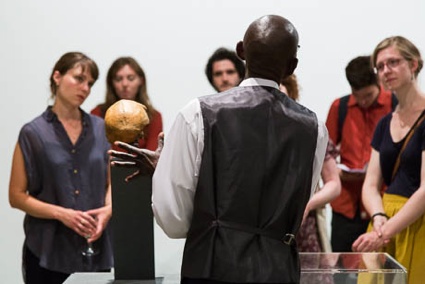 Pratchaya Phinthong, Broken Hill, 2013. Commissioned by Chisenhale Gallery. Photo: Mark Blower
Pratchaya Phinthong, Broken Hill, 2013. Commissioned by Chisenhale Gallery. Photo: Mark Blower
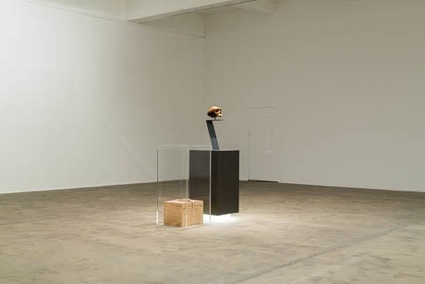 Pratchaya Phinthong, Broken Hill, 2013. Commissioned by Chisenhale Gallery. Photo: Mark Blower
Pratchaya Phinthong, Broken Hill, 2013. Commissioned by Chisenhale Gallery. Photo: Mark Blower
Except that right now, the Lusaka National Museum is not even exhibiting a replica but an identical model recently purchased online by a Thai artist. A replica of a replica, thus. The replica itself is on show, all alone in a big room, at Chisenhale Gallery in London.
Pratchaya Phinthong has loaned the replica skull and asked the museum guide, Kamfwa Chishala, to travel to London for the duration of the exhibition in order to communicate the history of the skull to the visitors of the art gallery, as he does in Lusaka. Kamfwa Chishala is thus the only genuine participant to this exhibition. He was invited by the artist to bring his own subjectivity and perspective to the story of the Broken Hill skull. Something he certainly does with passion. I’d recommend that you get to the gallery, listen to his presentation and have a chat with him. He’s a lovely man.
The Chisenhale exhibition is called Broken Hill -the nickname of the skull- and it uses the replica skull to investigate how historical narratives are performed through objects.
The replica skull is displayed with a copy of the wooden box where the original is kept at the NHM and with the export license that the artist had to obtain from the National Heritage Commission in Zambia because the replica skull is classified as a national relic. I thought the Zambian government was quite brave to allow the replica to travel to London since their attempts to repatriate the original to its country have all failed so far (tell that to the Greeks!)
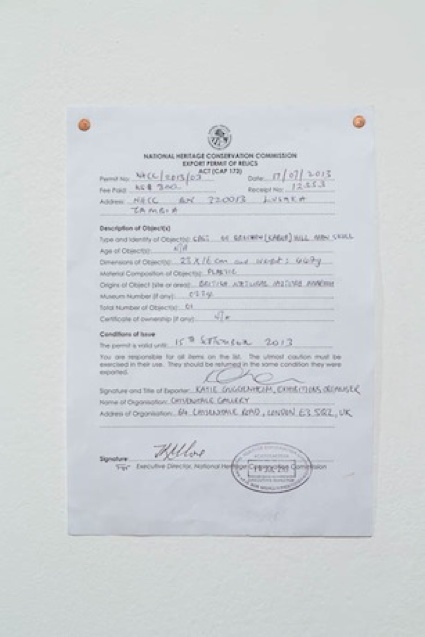 Pratchaya Phinthong, Broken Hill, 2013. Commissioned by Chisenhale Gallery. Photo: Mark Blower
Pratchaya Phinthong, Broken Hill, 2013. Commissioned by Chisenhale Gallery. Photo: Mark Blower
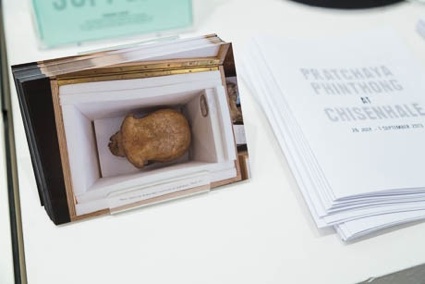 Pratchaya Phinthong, Broken Hill, 2013. Commissioned by Chisenhale Gallery. Photo: Mark Blower
Pratchaya Phinthong, Broken Hill, 2013. Commissioned by Chisenhale Gallery. Photo: Mark Blower
Broken Hill explores the provenance and the authenticity of artefacts but also the way human interference further complicates their status. The exhibition is the outcome of a network of personal relationships between individuals living in cities as different from each other as Lusaka, Bangkok and London.
After all these years seeing skull after skull in art galleries and contemporary art fairs, it was time some artist put a skull in a context that is more than simply anecdotal, sensational or sloppily ‘zeitgeist’-conscious.
Broken Hill remains open at the Chisenhale gallery until 1 September 2013. The real skull is on view as part of the Treasure exhibition at the National History Museum.
